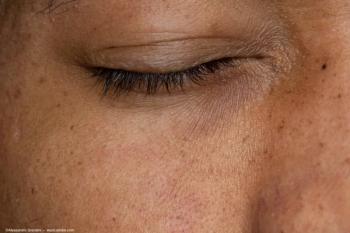
Interim results favorable for dye-enhanced feeder vessel treatment
Key Biscayne, FL—Preliminary analyses from a phase II study demonstrate the feasibility of dye-enhanced photocoagulation (DEP) feeder vessel treatment (FVT) in eyes with minimally classic choroidal neovascularization (CNV) associated with age-related macular degeneration (AMD). This new technique may have benefits compared with laser photocoagulation FVT alone for both increasing the efficiency of the procedure and allowing for treatment of larger diameter vessels, said Giovanni Staurenghi, MD, at the annual meeting of the Macula Society.
Key Biscayne, FL-Preliminary analyses from a phase II study demonstrate the feasibility of dye-enhanced photocoagulation (DEP) feeder vessel treatment (FVT) in eyes with minimally classic choroidal neovascularization (CNV) associated with age-related macular degeneration (AMD). This new technique may have benefits compared with laser photocoagulation FVT alone for both increasing the efficiency of the procedure and allowing for treatment of larger diameter vessels, said Giovanni Staurenghi, MD, at the annual meeting of the Macula Society.
Photocoagulation FVT treats CNV by closing the afferent feeder vessels supplying blood to the abnormal choroidal neovascular complex. The DEP procedure is performed using an investigational system (OPTTX-2N1, Novadaq Technologies) that combines indocyanine green (ICG) imaging and laser treatment capabilities in a single device and allows the retinal specialist to identify the feeder vessel in real time during the treatment procedure. By enabling visualization of the feeder vessel throughout the procedure, it is expected to increase the accuracy and effectiveness of feeder vessel photocoagulation. Vessel closure may also be augmented in this approach because the 810-nm wavelength of the diode laser used for photocoagulation is highly absorbed by ICG dye within the feeder vessel.
Dr. Staurenghi is the principal investigator for the single-center, phase II trial. It is randomly assigning 40 patients to traditional FVT or to treatment performed with ICG dye enhancement and will follow them for 1 year.
"These are early data from a phase II study that has safety assessment as its primary objective. Therefore, no conclusions can be drawn about the efficacy of the dye-enhanced FVT and its potential role in the future for managing exudative AMD. So far, however, it seems that the dye makes FVT easier to perform, and if the results continue to be favorable, we would expect this technique will become another useful therapeutic option for wet AMD," said Dr. Staurenghi, associate professor of ophthalmology, department of otorhinolaryngologic and ophthalmologic science, University of Milan, Italy.
The OPTTX-2N1 system consists of a fundus camera that was modified for ICG angiography and DEP by replacing its xenon flash lamp with an 810-nm diode laser. The laser's output fiberoptic is mounted on a joystick-controlled micromanipulator in the camera's optical system to allow precise positioning of the laser beam on the fundus. The retina specialist views ICG transit through the choroidal vasculature in real time through CCD video camera-acquired images displayed on an LCD monitor. The joystick is used to track the laser-aiming beam against the moving ICG dye bolus, and the laser is fired when the dye enters the target feeder vessel.
"It was really quite impressive to watch the real-time passage of the dye through the vasculature, and using this system, it was possible to deliver the laser beam accurately to the feeder vessel when it filled with ICG dye," Dr. Staurenghi said.
"With this technology we were also able to identify a new angiographic sign of feeder vessel closure that was characterized by temporary incarceration of the dye within the feeder vessel immediately after the treatment," he added.
In the phase II trial, the photocoagulation treatments in both groups were delivered with a 100- to 200-µm spot size. For the traditional FVT, the power was increased serially from 200 to 500 mW and the exposure time was 100 msec. In the DEP procedure, the power was stepped up in the range from 200 to 800 mW and the exposure time was 500 msec.
Newsletter
Don’t miss out—get Ophthalmology Times updates on the latest clinical advancements and expert interviews, straight to your inbox.


















































.png)


